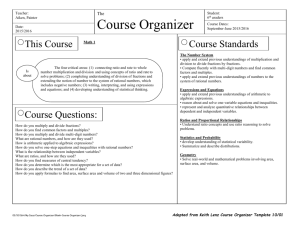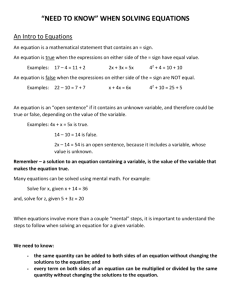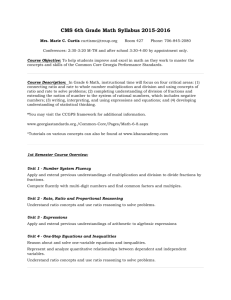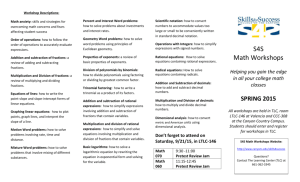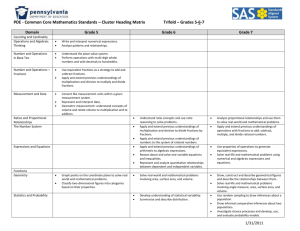3.1.1.DomCritArea.H2
advertisement
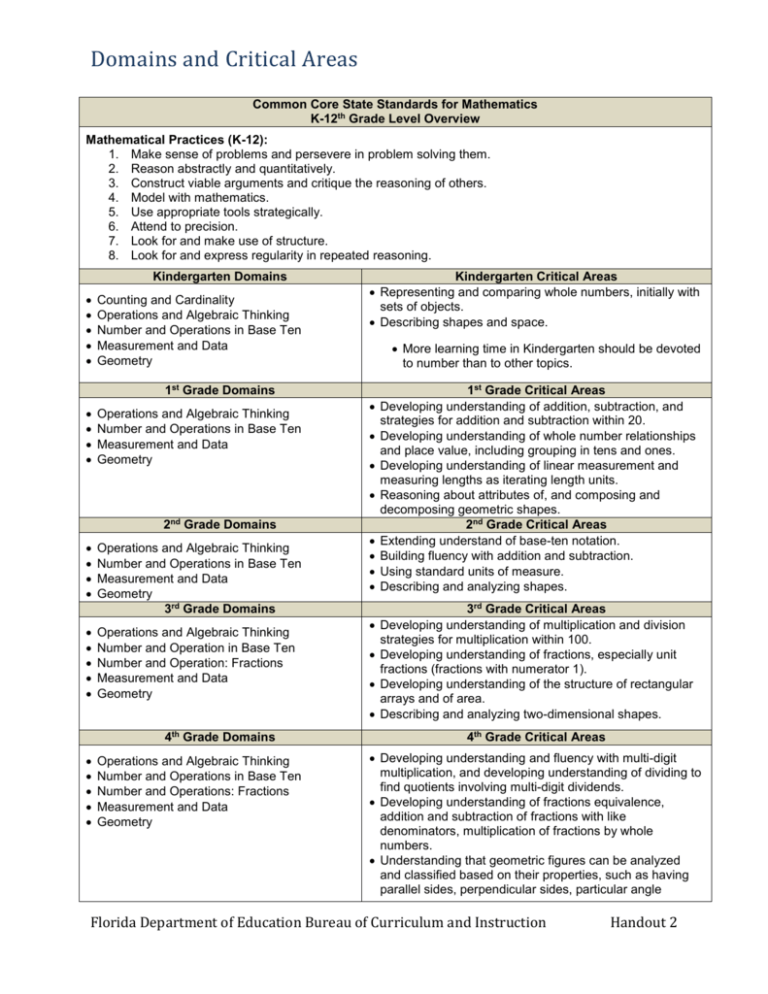
Domains and Critical Areas Common Core State Standards for Mathematics K-12th Grade Level Overview Mathematical Practices (K-12): 1. Make sense of problems and persevere in problem solving them. 2. Reason abstractly and quantitatively. 3. Construct viable arguments and critique the reasoning of others. 4. Model with mathematics. 5. Use appropriate tools strategically. 6. Attend to precision. 7. Look for and make use of structure. 8. Look for and express regularity in repeated reasoning. Kindergarten Domains Counting and Cardinality Operations and Algebraic Thinking Number and Operations in Base Ten Measurement and Data Geometry Kindergarten Critical Areas Representing and comparing whole numbers, initially with sets of objects. Describing shapes and space. More learning time in Kindergarten should be devoted to number than to other topics. 1st Grade Domains Operations and Algebraic Thinking Number and Operations in Base Ten Measurement and Data Geometry 2nd Grade Domains Operations and Algebraic Thinking Number and Operations in Base Ten Measurement and Data Geometry 3rd Grade Domains Operations and Algebraic Thinking Number and Operation in Base Ten Number and Operation: Fractions Measurement and Data Geometry th 4 Grade Domains Operations and Algebraic Thinking Number and Operations in Base Ten Number and Operations: Fractions Measurement and Data Geometry 1st Grade Critical Areas Developing understanding of addition, subtraction, and strategies for addition and subtraction within 20. Developing understanding of whole number relationships and place value, including grouping in tens and ones. Developing understanding of linear measurement and measuring lengths as iterating length units. Reasoning about attributes of, and composing and decomposing geometric shapes. 2nd Grade Critical Areas Extending understand of base-ten notation. Building fluency with addition and subtraction. Using standard units of measure. Describing and analyzing shapes. 3rd Grade Critical Areas Developing understanding of multiplication and division strategies for multiplication within 100. Developing understanding of fractions, especially unit fractions (fractions with numerator 1). Developing understanding of the structure of rectangular arrays and of area. Describing and analyzing two-dimensional shapes. 4th Grade Critical Areas Developing understanding and fluency with multi-digit multiplication, and developing understanding of dividing to find quotients involving multi-digit dividends. Developing understanding of fractions equivalence, addition and subtraction of fractions with like denominators, multiplication of fractions by whole numbers. Understanding that geometric figures can be analyzed and classified based on their properties, such as having parallel sides, perpendicular sides, particular angle Florida Department of Education Bureau of Curriculum and Instruction Handout 2 Domains and Critical Areas 5th Grade Domains Operations and Algebraic Thinking Number and Operations in Base Ten Number and Operations: Fractions Measurement and Data Geometry 6th Grade Domains Ratios and Proportional Relationships The Number System Expressions and Equations Geometry Statistics and Probability 7th Grade Domains Ratios and Proportional Relationships The Number System Expressions and Equations Geometry Statistics and Probability 8th Grade Domains The Number System Expressions and Equations Functions Geometry Statistics and Probability measures, and symmetry. 5th Grade Critical Areas Developing fluency with addition and subtraction of fractions, developing understanding of the multiplication of fractions and of division of fractions in limited case (unit fractions divided by whole numbers and whole numbers divided by unit fractions). Extending division to 2-digit divisors, integrating decimal fractions into the place value system and developing understanding of operations with decimals to hundredths, and developing fluency with whole number and decimal operations. Developing understanding volume. 6th Grade Critical Areas Connecting ratio and rate to whole number multiplication and division using concepts of ratio and rate to solve problems. Completing understanding of division of fractions and extending the notation of numbers to the system of rational numbers which includes negative numbers. Writing, interpreting, and using expressions and equations. Developing understanding of statistical thinking. 7th Grade Critical Areas Developing understanding of and applying proportional relationships. Developing understanding of operations with rational numbers and working with expressions and linear equations. Solving problems involving scale drawings and informal geometric constructions, and working with two-and threedimensional shapes to solve problems involving area, surface area, and volume. Drawing inferences about populations based on samples. 8th Grade Critical Areas Formulating and reasoning about expressions and equations, including modeling an association in bivariate data with a linear equation, and solving linear equations and systems of linear equations. Grasping the concept of a function and using functions to describe quantitative relationships. Analyzing two-and-three dimensional space and figures using distance, angle, similarity, and congruence, and understanding and applying Pythagorean Theorem. Florida Department of Education Bureau of Curriculum and Instruction Handout 2 Domains and Critical Areas Algebra 1 Domains The Real Number System Quantities Seeing Structure in Expressions Arithmetic with Polynomials and Rational Expressions Creating Equations Reasoning with Equations and Inequalities Interpreting Functions Building Functions Linear, Quadratic, and Exponential Models Interpreting Categorical and Quantitative Data Geometry Domains Congruence Similarity, Right Triangles, and Trigonometry Circles Expressing Geometric Properties with Equations Geometric Measurement and Dimension Modeling with Geometry Conditional Probability and the Rules of Probability Using Probability to Make Decisions Algebra 2 Domains The Complex Number System Seeing Structure in Expressions Arithmetic with Polynomials and Rational Expressions Creating Equations Reasoning with Equations and Inequalities Interpreting Functions Building Functions Linear, Quadratic, and Exponential Models Trigonometric Functions Interpreting Categorical and Quantitative Data Algebra 1 Critical Areas Relationships between Quantities and Reasoning with Equations; Analyze and explain the process of solving an equation. Linear and Exponential Relationships; Learn function notation and develop the concept of domain and range. Descriptive Statistics; Learn formal means of assessing how a model fits (data regression techniques, graphical representations and goodness of fit.) Expressions and Equations; Create and solve equations, inequalities, and systems of equations involving quadratic expressions. Quadratic Functions and Modeling; Comparing key characteristics. Geometry Critical Areas Congruence, Proof, and Constructions; Establish triangle congruence criteria, based on analyses of rigid motions and formal constructions. Similarity, Proof, and Trigonometry; Build a formal understanding of similarity. Extending to Three Dimensions; extending knowledge to include informal explanations of circumference, area and volume formulas. Connecting Algebra and Geometry Through Coordinates; Build on work with the Pythagorean Theorem to find distances, use a rectangular coordinate system to verify geometric relationships. Circles with and without Coordinates; Prove basic theorems about circles. Application of Probability; use the languages of set theory to expand the ability to compute and interpret theoretical and experimental probabilities for compound events. Algebra 2 Critical Areas Polynomial, Rational, and Radical Relationships; Develop structural similarities between the system of polynomials and the system of Integers. Trigonometric Functions; Use the coordinate plane to extend trigonometry to model periodic phenomena. Modeling with Functions; Identifying appropriate types of functions to model a situation, adjust parameters to improve the model, and compare models by analyzing appropriateness of fit and making judgments over the domain over which a model is a good fit. Inferences and Conclusions from Data; Identify different ways of collecting data and the role that randomness and careful design play in the conclusions that can be drawn. Florida Department of Education Bureau of Curriculum and Instruction Handout 2



